******* THE DRAGON FRUIT (OR PITAYA) ******
************ (OR PITAHAYA) ************
**** IS ALSO PRODUCED ON THE REUNION ISLAND ****
PAGE 2/3
No, you can't count on it yet, industrial production of Pitaya (Hylocereus undatus or ther Hylocereus fruit) in metropolitan France hasn't started yet ! The only fruits of these plants that I observed are three or four fruits I saw on one of the cliffs of the splendid " Jardin Exotique de Monaco" (Exotic Garden of Monaco).
But Pitaya is produced in the French overseas departments and more particularly on the Reunion Island. (red point on the map)
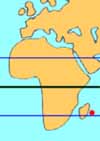
Documentation about this subject, which enabled me to write these pages, was very kindly communicated to me by Fabrice Bellec and Christian Lavigne, both of them researchers for the CIRAD (International co-operation to Agronomic Research Center for Development). I thank them here, very warmly, for the numerous texts and photos that they addressed to me, documentation resulting from their research.
PITAYA ON THE REUNION ISLAND
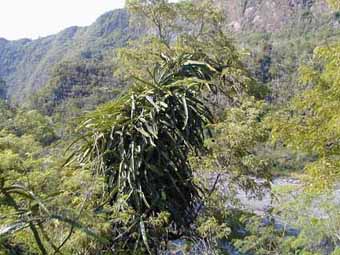
Hylocereus undatus, naturalized on the Reunion Island.
Originating from Central America, Hylocereus undatus is a plant naturalized long ago in the island: its presence has been attested there since 1895 (Jacob of Gordemoy in: "La flore de la RŽunion" (Flora of the Reunion Island). Another Hylocereus species can also be found, although its introduction is much more recent (the first known references date back to the 1990s): it's Hylocereus costaricensis.
Both plants normally bloom on the island, but they don't spontasneously bear fruit or at least very rarely.
FRUIT DIVERSITY OF THE REUNION ISLAND.
The fruit inheritance of the Reunion Island is very rich; almost
all the fruit species were introduced on the island. 138 different fruit species
were listed, among which only five have been grown (for only a few years)
for commercial purposes : mangos, litchis, pineapples, bananas and citrus
fruits. The rest of the fruit inheritance can be found in nature or is cultivated
only
in private gardens.
The CIRAD researchers wanted to diversify the island fruit production with a new fruit. Considering the richness previously evoked, it appeared useless to introduce a new species, more especially as species already present (as Hylocereus) don't require acclimatization any more, which saves time.
Since 1994 a double strategy has been carried out in order to decide which fruit species would be developed and later, to lead to the selected fruit production :
1- surveys targeting the future consumers, salesmen and farmers.
2- Research concerning growing and fructification.
1- SURVEYS TARGETING THE FUTURE CONSUMERS, SALESMEN AND FARMERS

The fruit which was going to be selected.
The species preselection was carried out according to the requirements of the various concerned actors :
For the consumer: there's the attractivity of the new fruit assessed according to its shape, its color and its taste as well as its easy consumption.
For the salesman: there's the interest in the new fruit related to its life span on the shop shelves, its conservation possibility and the regularity of its supplying.
For the farmer: there's the profitability of the new fruit farming, the fruit's easiness and a fast fruit obtention.
Hylocereus undatus and its fruit were selected and the research about its fructification and its growing started (see paragraph 2). At the same time, surveys were carried out targeting the already quoted actors; these surveys confirmed the validity of the choice and encouraged the proceedings of the research process.
Then (starting in 2000), the producers were contacted and started to grow. An advertising campaign was launched aiming at hotels, restaurants, agricultural exhibitions and in the press. The actual marketing started, financial assistance for the farmers wasn't necessary ; the farmers had adapted to the new growing.
The growing techniques are the result of stage number 2.
2- RESEARCH CONCERNING FRUCTIFICATION AND GROWING
How to induce fructification
As I wrote before, H. undatus and H. costaricensis seldom bear fruit spontaneously. Thus, it was necessary to understand why and also to find how to proceed so that fructification could occur. It was decided to proceed with several types of pollination, on an experimental plot, planted with a clone of H. undatus and a clone of H. costaricensis grown on vertical wooden stakes. This study was undertaken from December 1998 to May 2000.
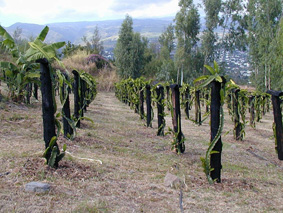
Experimental plot, plants are grown on individual stakes
The different studied pollination processes were :
(1) : manual self-pollination (2) : free night pollination
(3) : free day pollination (4) : manual cross-pollination
Negative results of processes (1) and (2) in 1999 (no fructification observed) led to continue only processes (3) and (4) in 2000. It ensued the following conclusions :
Each of both clones of Hylocereus was self-incompatible (no fruit with (1) for 200 pollinations).
Natural pollinating agents highlighted in processes (2) and (3) were bees.
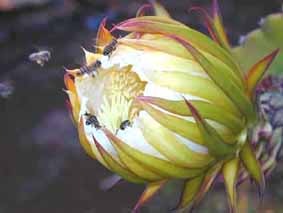

melliferous bees visiting Hylocereus blooms
However, night pollinations didn't produce any fruit and the day ones produced fruits of commercially insufficient size. The small size of the bees didn't enable them to deposit enough pollen on the pistils; however the fruits size increases with the quantity of pollen deposited.
It should be noted that in America, the natural pollinating agents of Hylocereus are bats and sphinges, absent on the Reunion Island.
The only process making it possible to obtain fruits of acceptable size was manual cross-pollination. This is the process which was adopted.
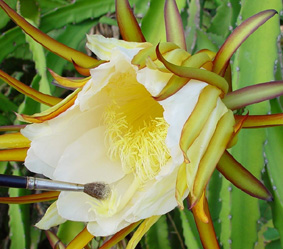
Pollinisation manuelle croisée d'une fleur d'H. costaricensis avec du pollen récolté sur H. undatus.
Moreover, F. Bellec created a hybrid between H. undatus and H. costaricensis, hybrid allowing to efficiently fertilize each of both parents.
Different growing techniques
Hylocereus can be propagated by cuttings or sowing, the first method being faster: it allows to obtain fruits 1 year after the propagation by cuttings against 3 years after sowing.
The seedlings are put into the soil at mutual distances according to the growing technique. As Hylocereus are climbing cacti, they grow and clutch onto any support, using their air roots. Usually, they grow along vertical wooden or concrete stakes, or on vertical or leanig metallic nettings, the latter method allowing to plant them nearer one another. Due to their weight, the plants must be pruned and attached on their support.
The Hylocereus root system being suprficial, a small quantity of mineral and organic nutriments is enough for them. A regular irrigation is favourable to obtain quality fruits.
The fruits, which weigh between 300 and 700 grams each, are collected approximately 30 days after pollination.
HOME PAGE ............... CONTINUATION AND END OF THE ARTICLE AND PHOTOS : page 3/3
BACK TO THE PAGE 1/3 ABOUT THE DRAGON FRUIT
_______________________________________